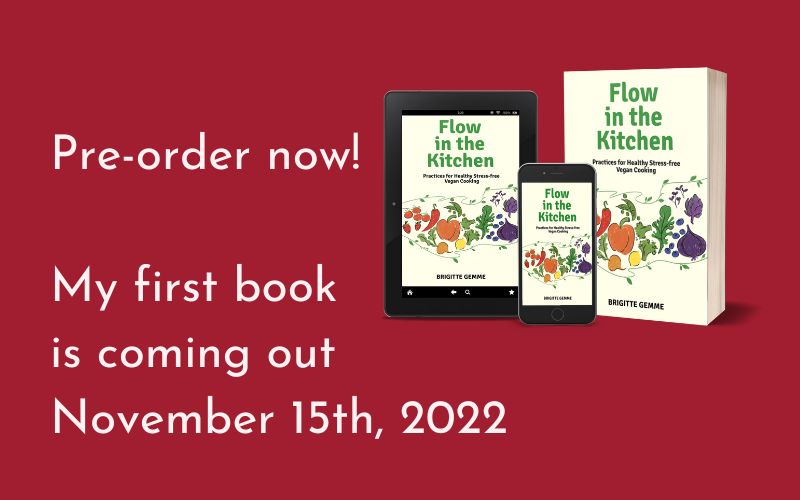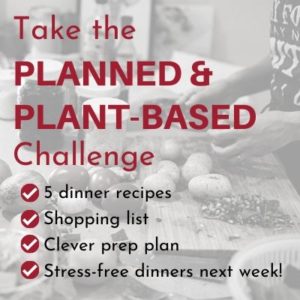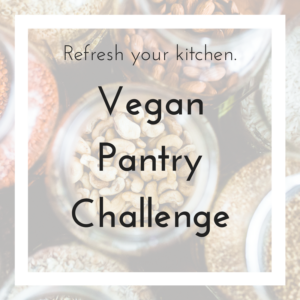Flow in the Kitchen: Practices for Healthy Stress-Free Vegan Cooking is not a cookbook. Cookbooks can be useful and beautiful… but they don’t make us cook. Who hasn’t ordered ready-made meals instead of cooking at home, despite having lots of cookbooks, a fridge full of fresh produce, and cabinets crammed with cookware? With Flow in the Kitchen, Brigitte Gemme proposes a different path.
Listen to this article or keep on reading below:
It’s a book written to inspire and motivate people to get in the kitchen and cook really good food for themselves and their loved ones. What is really good food? It’s food that promotes good health, is kind to the planet, avoids unnecessary suffering, is prepared with love, and taste good. Few meals will tick all those boxes, but it’s worth the time, effort, and attention to keep trying. After all, what is more important than ensuring that our food truly nourishes us, enabling us to show up in the world to live our best life and make a difference?
Practicing flow in the kitchen is not only about cooking but about the complete process of planning, preparing, and serving meals. Achieving flow means enjoying the ability to prepare nourishing meals in a focused, confident, and joyful way. Flow adds intention and direction to our cooking.
The first phase of flow requires connecting to our “why.” In the first chapter, I introduce my own motivations to embrace this way of life. I first came to plant-based cooking for the environment, later went vegan for the animals, and eventually grew motivated to promote healthy vegan cooking after seeing my father decline and die of dementia. It is not always an easy lifestyle but living with integrity is empowering.
Chapter 2 explains the importance of balancing priorities by striking conscious compromises. Most kitchen woes come from a mismatch between what we want and the resources we put toward those wishes. To get better at delivering upon the promises we make to ourselves, we must balance the scope of our food aspirations (how fancy and diverse we want the meals to be), the time and energy we have for cooking, and our budget. Simple meals can be really good food, too!
Thinking about really good food is a good place to start, but at some point, one must cook… yet so many of us (author included!) often resist cooking. “I’m sick of making dinner!” “Cooking feels like a waste of my time.” “I hate cooking!” In chapter 3, I draws on my sociology background to shed light on why we so often feel undervalued when we cook. I then invite you to flip your mindset to experience gratitude and joy instead of resentment and dread. To make this mindset shift easier, chapter 4 proposes over 20 practices that will help you embrace cooking, from putting on an apron to playing power songs, from energy reboot to high intensity interval cooking.
You now see why cooking really good food for yourself and your loved ones matters so much. You are ready to embrace the necessity of cooking with joy. But… what are you going to eat? That’s the focus of chapter 5, in which I demonstrate the process of improvising a healthy vegan meal step-by-step. The goal is to create a simple, delicious, and nutritious dish from whole plant ingredients. Once you understand what goes in the making of a single dish, chapter 6 invites you to string five or more together to create a vision of your weekly meal plan. Ever mindful of constraints, I include critical steps such as taking a hard look at your calendar and reviewing your food inventory before filling the blanks with brand-new meals. Believe it or not, the whole process can be done without turning to Google or Pinterest!
The next flow practice is batch cooking, which is about spending two hours on the weekend to prepare the building blocks that will make weeknight cooking so much less stressful. I explain how to deconstruct your meal plan into its pieces and offers a way to be more strategic about your batch cooking time.
Is two hours too much to dedicate to weekend cooking? What about one hour? That’s the “minimum viable prep” session that I recommend in chapter 8, which you might also call your “most valuable practice” when it comes to healthy stress-free vegan cooking. Even if you think you don’t have time to cook, it’s worth scraping an hour together to get some beans and whole grains ready, roast some orange vegetables, get greens prepared, and cook up a soup or stew. The chapter includes suggestions to make simple yet pleasant meals out of the food prepared in your MVP session.
If you’re trying to cook more food faster, in a more pleasant state of flow, you’ll want to follow my suggestion to embrace mindful, screen-free cooking. In chapter 9, I discuss how smart devices have infiltrated every sphere of our lives, including the kitchen. We are kidding ourselves if we think it’s improving our cooking practice. Are you prepared to take the screen-free cooking challenge?
Flow, by definition, means moving along steadily and continuously. In our modern “busy” life, maintaining such a blissful state in the kitchen will be a struggle in the face of schedule disruptions and “more important” demands on your time and energy. The concluding chapter offers tools you can wield against such obstacles. I also give you a strategy to get back in the rhythm when, inevitably, at some point, you miss a beat.
In the back of the book, I share the list of vegetables and pantry ingredients I always stock to be prepared to improvise healthy vegan meals. In addition, I explain how to cook whole grains, cook dry beans from scratch, the general method for preparing soups and stews, my favorite stir-fry technique, and how to compose satisfying salads and bowls. A section on pizza-making and tips to create “instant sauces” from pantry ingredients and leftovers complete the book. Instead of providing recipes to help you cook dinner tonight, I offer you the seeds you can plant to grow your own versions of standard vegan dishes, based on your preferences, ingredients you have at hand, and seasonal produce.
Readers get to download a free package of templates that will guide them through meal planning, grocery shopping, batch cooking, and reflecting upon their weekly meals.
If you’d like to learn more about Flow in the Kitchen and start practicing with me, I encourage you to pre-order the ebook on Amazon at the special $5 USD launch price. Just search for “Flow in the Kitchen.” Your book will be automatically delivered to your Kindle reader or mobile device equipped with the Kindle app on November 15th.
If you have any questions, or if you’d like to invite me to chat about Flow in the Kitchen for your podcast, blog, or magazine, send me an email at [email protected].



